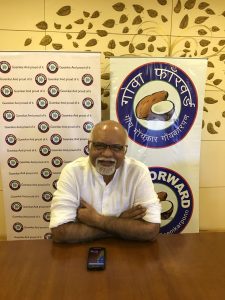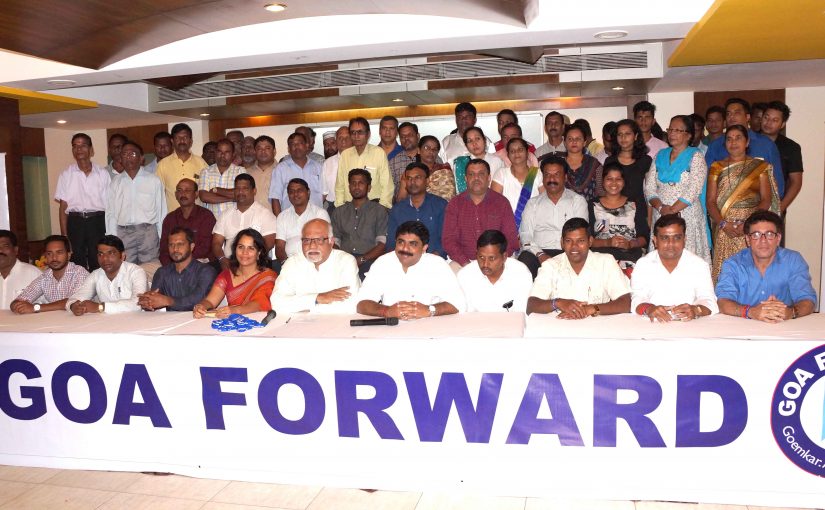HAPPIER TIMES: Many BJP workers from Margao left the BJP to join the Goa Forward. They have now come full circle as Goa Forward has joined the BJP government it once criticised so vocally
The eminent historian reveals his involvement with the formation of Goa Forward and his contribution to defining Goenkarponn. He however laments the fact that even modern Goans have failed to shed their caste prejudices.
By Teotonio R. de Souza
IN EARLY September a year ago, I published my reflections on Goan identity under the caption “Goenkarponn simplified”. Anyone searching for it online along with my name will not fail to find the published version. In response to it I received a message from Mr. Prabhakar Timble on September 10, 2016, thanking me for my reflections. He also attached files containing 24 points of the key commitments, and a list of 26 Indian (including Goan) historic personalities that would inspire and guide Goa Forward, a party he had just founded.

Prabhakar Timble added to the above message: “We are in the process of preparing our detailed agenda for different sectors and sections. For this, we have started meeting the stakeholders and interest-groups such as the Chambers of Commerce, industry associations, NGOs and social activists.
We will keep you posted on the detailed agenda once the same is finalised. We shall be glad if you could write about our key commitments in your regular columns.”
Following the outcome of the elections a couple of weeks ago and the formation of the new Government I feel vindicated about my published reflections about “Goenkarponn” adopted by Goa Forward as its election banner. With all due respect to Mr. Timble and his old-age political adventurism, I would not hesitate now to name my fresh reflections on “Goenkarponn simplified” as “Timbleponn”, with Vijaiponn as what we call in Goa “faddem”, thrown in by the seller for a good measure after a good buy.
Over the years, many of us may have come across ‘Teach Yourself’ books with appealing titles, like ‘Learn German without Tears’, ‘Calculus simplified’, etc. My earlier article followed an interview by Mr Prabhakar Timble on a local channel. He was speaking about the new political party that he was going to lead, named Goa Forward.
GOA FORWARD
AMONG other ideas, Mr Timble shared his new party programme. I listened with delight to his definition of Goenkarponn. We were told that it was not simple, meaning possibly not linear or logical, but emotional reality.
So far so good. One even prefers today to measure EQ or EI, rather than IQ. But granted all that in favour of emotional intelligence, as I myself acknowledged at the beginning of a conference about Goan identity at the Goa University in 1999, organised in collaboration with the University of Sorbonne – Bordeaux, the academic component cannot be entirely ignored in defining identity, specially by someone known to be an educationist and wishing to enlist university students as agents of social and political change.
The scholastic wisdom in which I was trained emphasised two essential elements in a good definition, namely (1) it should be brief, and (2) it should be adequate. These imply that a definition should not be longwinded, and should not need another or more definitions to define the definition. I felt that Mr Prabhakar Timble’s definition of Goenkarponn fell short of these requirements.
Now that I am re-writing “Goenkarponn simplified”, I would not hesitate to retitle it “Timbleponn”. No ridicule is meant, only a serious critical homage, mixed with some humour, knowing well my Saxtikar relations and friends who are made of a better stuff than the crest-fallen Good Friday faithful. The programme of Goa Forward needed many clarifications before the elections to satisfy Goans of “diverse” wishes and thinking, as admitted by Mr Prabhakar Timble himself. He stated that Goenkarponn included multilinguism and multiculturalism among many other things. These are central concerns of Goans today.
Within the short time allotted to an interview with a local TV station, Mr Timble touched upon the MoI issue and referred to a committee appointed to study it against the new concept of primary education as defended by UNESCO. It was shocking to hear that the concept of mother tongue was no longer relevant, and that it could be replaced with the language of the ayahs among others. Curiously, the Portuguese did not protect Konkani at primary level because for them Konkani was the language of the servants (criados).
I believe that neither multilinguism nor multiculturalism can be left to the interpretation of an international body, such as UNESCO, which has shown no capacity or will to enforce its model concepts upon European countries which continue imposing their national languages upon immigrants, with hardly any question of concession of grants to them at any level.
Language and religion constitute the twin-soul of any culture. After the colonial meddling with the Hindu religion of the Goans, the Konkani language is all that is left of Goan culture. Is that also negotiable, and can’t the State government enforce laws to safeguard its survival? One could investigate UNESCO criteria and grants for protecting world heritage. When did that policy start and what is the relative number of monuments left behind by ex-colonial powers and included in the world heritage list vis-a-vis the monuments of pre-colonial times? What does that suggest? Obviously, a preference for colonial heritage and their past glories. One could extend the analysis to other discriminatory bodies associated with the United Nations.

How innocent or effective has been the running of the International Criminal Court (ICC) vis-a-vis the war-lords of the West as compared with the non-Western political leaders? Quite a few of the world powers in the West should have been “guests” of the ICC for the genocidal wars under their regimes, but they seem to be beyond jus cogens, if non-signatories of the Rome statute of 1998. Only the African leaders have been at the receiving end, and some of them have shown their guts in opting out of it. Who will bell the cat? Will Mr Timble follow their pedagogy to lead Goa Forward?
Despite my few caveats I admired Mr Timble’s courage in leading a timely cause. Hopefully “forward” would not mean shifting the gears to “fast forward”, and would restrain the usually enthusiastic Saxtikar from diving head first, after some extra shots of urrak which they may be stocking in large amount in the face of the ongoing threats to coconut tree plantations. If need be, they may share cashew feni with the Bardezkar and the Goenkar of new conquests where no equivalent threats have been announced. But for that Goa Forward will need to weld all Goans together, and shun any traditional intra-regional prejudices.
Following the election results Mr. Timble’s young turk moved “faster forward” leaving Timble behind and everyone else aghast! Probably the recent visit of the Portuguese prime minister of Goan origin and with Margão links inspired the BJP in Goa to follow his cue. Portugal à Frente or Portugal Forward, a coalition of the centre-right parties in the most recent elections in Portugal had gained majority, but the Saxtikar Antonio Costa took away their victory from their mouth by forming a coalition with the left parties, something that no one had achieved before in the history of Portuguese democracy.
PEELING THE GOAN ONION
FOLLOWING my reflections on Goan identity mentioned above, I was asked in 2008 to write again on the same theme. I produced an essay entitled “Identifying identities” with a reference to “Peeling the Onion”, the recent autobiographical and polemical novel of Günter Wilhelm Grass, recipient of the 1999 Nobel Prize for Literature. That is exactly how I see the Goan identity with its many wrappings. Some of these make me cry, due to the ambiguities and contradictions involved in the process of the historical growth of “my people”.
Our personal destiny is greatly shaped by developments of our collective history that are not of our choosing. Mine was no exception and some important life decisions became dependent upon the best available opportunities, but hardly of my choice. Conceived in Kalyan, where my father worked for a British military camp just before India’s Independence, my mother returned to our home-village in Goa to give birth. It was only in 1995 that I could find the right conditions to re-orient my life. Recovery of Portuguese nationality was then an option. Similarly, the recovery of Indian nationality as an OCI in 2007 was another option.
Those were hard and thoughtful decisions, and reflect my way of integrating consciously, freely and appreciatively the major elements that have contributed to shape my identity as a Goan. In the past I would view these same elements as being forced into my identity. Now I feel that I have come to terms with my identity and feel proud of it. That is a process I wish for every Goan.
The post-liberation generations, and most visitors and recent settlers in Goa, are not sufficiently clear about what precisely makes up the Portuguese cultural legacy. Many “outsiders” (bhaile for the native Goans) come imbibed with Salman Rushdie’s imagery of Goans who love to light candles to the kababed saints and tandooried martyrs which they preserve reverentially in the home oratories. At the close of the Portuguese colonial regime in Goa, after nearly four and half centuries of intense and sustained battering of the Portuguese law, church rituals and inquisition threats, on a small enclave, Goans could not escape adopting overt and covert cultural habits that distinguish them from the rest of the inhabitants of the subcontinent.
To illustrate the reaction of the Goan Christian elite to liberation, I cannot resist quoting a somewhat lengthy paragraph from Rushdie’s The Moor’s Last Sigh depicting a character modelled after Mario Miranda: “When…the Indian Army entered Goa, ending 451 years of Portuguese colonial rule …Vasco was plunged for weeks into one of his black-dog depressions. Aurora encouraged him to see the event as a liberation, as many Goans did, but he was inconsolable. ‘Up to now I had only three Gods and the Virgin Mary to disbelieve in,’ he complained. ‘Now I have three hundred million. And what Gods! For my taste, they have too many heads and hands’… On the night of India’s independence, the red mist came over him in a rush. The contradictions of that high moment tore him apart. That celebration of freedom whose engulfing emotions he could not avoid even though, as a Goan, he was technically not involved… he drank vinho verde in quantity and at speed, sunk in darkness.”
IMPACT ON GOANS
THE impact of the Portuguese brand of Christianity could also be felt on ordinary rural Goan Christian women. For instance, they all love to put flowers in their hair just as any Goan woman would, but they take them off when leaving home. I asked my mother once why she did that, and she explained: Kristanv bail ghara bhair fulam mau na (Christian women don’t wear flowers in their hair outside the house). I discovered a reason much later, in the course of my research. In the course of the 16th century the church provincial councils had decreed under severe penalties that Christian women should discontinue a practice of divination whereby they would stick flower petals with saliva to the left or right side of a temple idol and wait to see which petal would fall first to decide if a wish would be granted or not. Banning the use of flowers in the hair while outdoors could help prevent the temptation to continue an old “gentile” practice.
For these and other “lapses and re-lapses” many Goans were hauled before the Inquisition Tribunal and punished at autos-da-fé during two and half centuries of its operation in Goa. We can only imagine from a distance in time the intimidation and terror it may have had on men and women torn away from their families and kept in the dungeons of the Inquisition. Several of these never returned to their families, or perhaps some did after serving six to ten years as forced labour in galleys or gunpowder factory.
The Provincial superior of the Goa Jesuits, my co-villager from Moirá and a trained psychologist, Fr. Tony da Silva S.J., analysed many years ago, in a seminar I organized at the Xavier Centre of Historical Research in 1992, the permanent impact such inquisitorial intimidation left upon the Goan psyche or Goenkarponn for times to come. We are experiencing the unwinding in some of the social excesses that we have been witnessing in the post-liberation era.
I wish to recall another incident that left me baffled many years ago. It was the statement of an orthodox Hindu Brahmin from Pune. He came to Goa in the wake of the liberation as the Director of Goa Historical Archives and stayed in that job till his retirement about 20 years later. Like many other such non-Goan officers that were little welcomed by Goans and were labeled as “deputationists”, he too decided to live his retired life in Goa. Dr. Gune acquired a house near Mangueshi temple and believed that he could continue his hobby as astrologer (jyotishi) and earn to complement his pension.

My great surprise was to hear him say, some three years later, that he had decided to leave Goa. He was disillusioned with Goan Hindus, whom he denounced as “different”, a milder way of saying that they were corrupted by the Portuguese influence. They did not meet his requirements of Hindu orthodoxy! Until that moment I had only noticed (like most Goans do till today) the differences between Goan Hindus and Christians. I needed a Hindu from outside Goa to bring the similarities among Goan Christians and Hindus to my notice. Goa had been in its past history, at least since the 11th century under the Kadambas, linked to a widespread network of Afro-Asian seaborne trade, and of hinterland trade with the Deccan through ghat passes.
The integration of Goa into the Portuguese eastern empire after 1510 catapulted it into an unforeseen scale of operations. As headquarters of an early modern European empire from 1530, Goa exposed its inhabitants very early to the challenges of modern globalization.
If the early decline of the Portuguese failed to sustain this process, the economic pressures and the cultural acquisitions permitted the Goans to avail of the opportunities presented by the British empire in the neighbouring territories, particularly since the establishment of the rail link. Ironically, the allegedly harassed Hindu community of Saraswats (one-sided historical perspective conveniently bandied around for political gains in post-liberation times) sustained the fiscal-commercial structure of the Portuguese in Goa, and the Hindu dubhashis effectively served their diplomatic needs in Asia as extensively documented by Dr. P.S.S. Pissurlencar in his Agentes da Diplomacia Portuguesa na Índia (1952).
Without such vital support the Portuguese colonialism in Goa would have been short-circuited and burnt out very much earlier than it did. But the self-interested collaboration of Goan Hindus gave lots of time for masses of poor Christians, allegedly protected by the Portuguese Christian rule, to make a bee-line as emigrants to eke out their living in British India. I will come back to this trait in my parting shot at the end of this essay.
CHURCH IMPACT
IT SHOULD never be forgotten that it was the structure of the Portuguese Church Padroado throughout Asia, manned largely by native Goan clergy from the 19th century onwards, that gave the scattered Goan emigrants the emotional sustenance they needed away from their homeland. The Padroado parishes in Bombay and the village kudd dedicated to the patron-saints of the respective parishes in Goa were the visible and effective props in the process of adaptation to painful socioeconomic challenges faced by Goan emigrants. The church connection also helped develop the musical talent of many Goans, and the westernized culinary skills opened job markets for many Goans in British India. Sad to say also, the tradition of an international slave market where females and males from different countries were bought and sold (and that made Portuguese Goa famous through the writings of the Dutchman Linschotten and other contemporary foreign travellers) contributed to the exodus of many Goan women who earned their living with prostitution in Bombay. If language is a core component of any social identity, it may surprise us to find that Goans preserved their language even during the colonial period, and barely 5 per cent of Goan population could read, write and speak in Portuguese according to the last census of the colonial regime. These included ethnic Portuguese serving in Goa and about one hundred families of mestiços and luso-descendentes.
However, close contact with the Portuguese clergy during the early centuries after conversion, elementary training in the parish schools, and compulsory primary schooling in Portuguese since the 50s, resulted in the absorption of a hefty proportion of Portuguese loan-words into the spoken Konkani of Goan Christians. Fuj-da-put (filho da puta), bonku (bom cú), fodricho (foder), etc. became common folk utterances alongside besanv (benção), maldisanv (maldição), etc. Such linguistic colonialism, despite the colourful ingredients, greatly endangered the healthy growth of Konkani language and many decades of sustained efforts became necessary after 1961 to restore its linguistic-cultural legitimacy and standards so as to make it acceptable as the official State language in 1986 and to permit its entry in the Constitutional schedule in 1992.
GOAN CASTE SYSTEM
WHETHER we like it or not, no discussion on Goan identity can be complete by ignoring the caste system that dogs the Goan society. “To konnalo?” (to which family does he belong?) is a question which a Goan usually asks or intends to ask, be it in Goa or anywhere in the world. Goans married to non-Goans and living in non-Goan ambiance may care to ignore the caste linkage, and even in Goa today money and power call the shots. However, deep in the unconscious a Brahmin knows he is a Brahmin, a Chardo resents being a Chardo, and the same old trap works. Spoken Konkani retains grammatical inflections and vocabulary preferences that identify castes, such as aila and eila, taka and teka, sokoilo and khailo, etc.
Despite all the haute couture and other external shenanigans that Goans have acquired over time that makes them presentable global citizens, the Goan identity has yet to break out of its caste-shell. A glance at the archives of Goanet, (the oldest global Goan Internet discussion forum) should confirm my point. Thus caste remains a challenge for Goans for yet another millennium. It is what the Portuguese would call a pedra no sapato, a cultural irritant that we need to learn to freely detach from the requisites of our personal and collective identity. Until we can eradicate it, we can hardly call ourselves global Goans. We will remain puny caste-bound Goans doing relatively well globally.
To conclude this essay on “Goenkarponn that makes me cry”, I shall not forget an interview of Vijai Sardesai to Prudent Media. He sought to convince his interviewer that Goenkarponn includes trust, and that despite his “strategic” shift to a rival political party for which he had no good word during the election campaign, he would not fail to serve Goenkarponn. Probably he meant Goenkarponn of a certain caste that has a long history of political pragmatism in Goa. Soon after the Portuguese conquered Goa they registered some of the old Goan customs (of the higher castes) in a so-called Foral de Afonso Mexia (1526). Among those customs we can read about various types of oaths and swearings (Konkani soput). Did the trustworthy Goans need them?
